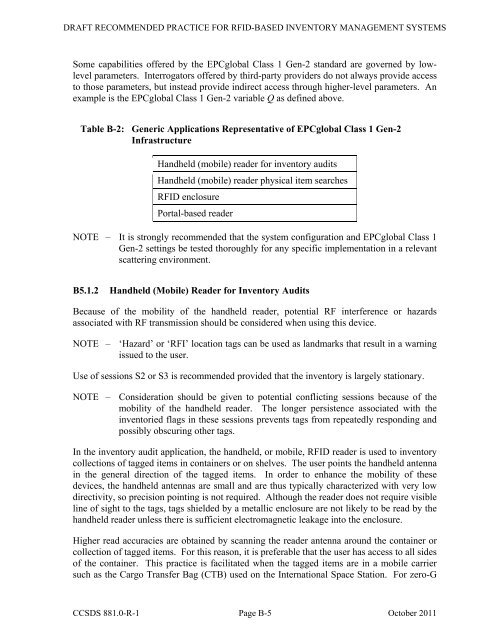CCSDS 881.0-R-1, Spacecraft Onboard Interface ServicesâRFID ...
CCSDS 881.0-R-1, Spacecraft Onboard Interface ServicesâRFID ...
CCSDS 881.0-R-1, Spacecraft Onboard Interface ServicesâRFID ...
You also want an ePaper? Increase the reach of your titles
YUMPU automatically turns print PDFs into web optimized ePapers that Google loves.
DRAFT RECOMMENDED PRACTICE FOR RFID-BASED INVENTORY MANAGEMENT SYSTEMSSome capabilities offered by the EPCglobal Class 1 Gen-2 standard are governed by lowlevelparameters. Interrogators offered by third-party providers do not always provide accessto those parameters, but instead provide indirect access through higher-level parameters. Anexample is the EPCglobal Class 1 Gen-2 variable Q as defined above.Table B-2: Generic Applications Representative of EPCglobal Class 1 Gen-2InfrastructureHandheld (mobile) reader for inventory auditsHandheld (mobile) reader physical item searchesRFID enclosurePortal-based readerNOTE – It is strongly recommended that the system configuration and EPCglobal Class 1Gen-2 settings be tested thoroughly for any specific implementation in a relevantscattering environment.B5.1.2Handheld (Mobile) Reader for Inventory AuditsBecause of the mobility of the handheld reader, potential RF interference or hazardsassociated with RF transmission should be considered when using this device.NOTE – ‘Hazard’ or ‘RFI’ location tags can be used as landmarks that result in a warningissued to the user.Use of sessions S2 or S3 is recommended provided that the inventory is largely stationary.NOTE – Consideration should be given to potential conflicting sessions because of themobility of the handheld reader. The longer persistence associated with theinventoried flags in these sessions prevents tags from repeatedly responding andpossibly obscuring other tags.In the inventory audit application, the handheld, or mobile, RFID reader is used to inventorycollections of tagged items in containers or on shelves. The user points the handheld antennain the general direction of the tagged items. In order to enhance the mobility of thesedevices, the handheld antennas are small and are thus typically characterized with very lowdirectivity, so precision pointing is not required. Although the reader does not require visibleline of sight to the tags, tags shielded by a metallic enclosure are not likely to be read by thehandheld reader unless there is sufficient electromagnetic leakage into the enclosure.Higher read accuracies are obtained by scanning the reader antenna around the container orcollection of tagged items. For this reason, it is preferable that the user has access to all sidesof the container. This practice is facilitated when the tagged items are in a mobile carriersuch as the Cargo Transfer Bag (CTB) used on the International Space Station. For zero-G<strong>CCSDS</strong> <strong>881.0</strong>-R-1 Page B-5 October 2011

















